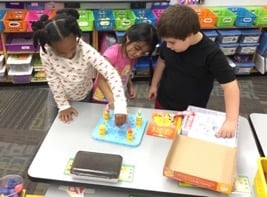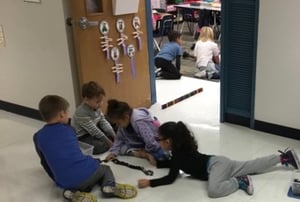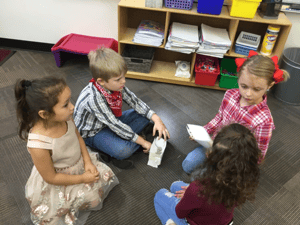
Co-teaching can be a very effective way to teach students. This concept can be defined as two teachers collaborating to design, implement, and assess instruction. There are various ways to co-teach: one teaches while one observes; one teaches while one assists; parallel teaching, where the class is split into two groups and presented the same information; station teaching, where two teachers are at different stations and students move to each station for instruction; alternative teaching, where one teacher pulls a small group of students for intense instruction while the other teaches the whole group; and team teaching, where two teachers teach the same content at the same time.
This year, my colleague and I decided to use the team teaching approach to implement a Project Lead the Way module about pushes and pulls to our kindergarten students. Here’s what we learned:
- Partnership: First, we sat down together to plan and organize. While we do have similar teaching styles, she has six years of teaching experience while I have over twenty. It was so refreshing to hear her new ideas, and she appreciated working with a “veteran.” It was fun working together to come up with a unit that was both engaging and challenging for our students, and we shared the responsibility for both instruction and management. Our Project Lead the Way module gives very specific objectives and procedures for this STEM unit. However, using our shared expertise, we were able to decipher the best way to implement it together. There were some lessons where we felt combining the classrooms would be more effective, and other times when we started off in our own classrooms and came together later for student collaboration.
- Implementation: The primary goals of this module were introducing the profession of engineering, and how engineers use the design process to create new products or make existing products better, as well as teaching students that force is a push or pull—and how this force can change depending on certain variables, such as when forces collide. Initially, we introduced our classes to each other as their “engineer buddies.” One of our first lessons was reading a non-fiction story about force and then students walked with their buddies around the school to hunt for signs of pushing or pulling.
 In another lesson, we read a story to both classes introducing a product using pushing and pulling. It was very convenient to have both classes together because while one teacher read, the other teacher was able to get the materials ready to assemble the “spinning machine.” Because of this, there was very little transition time after the story was read before assembling the machine. Another successful lesson had students moving to different stations set up in both classrooms so they could experiment with pushing and pulling. Co-teaching allowed us to have more stations set up for student experimentation, leading to more hands-on engagement.
In another lesson, we read a story to both classes introducing a product using pushing and pulling. It was very convenient to have both classes together because while one teacher read, the other teacher was able to get the materials ready to assemble the “spinning machine.” Because of this, there was very little transition time after the story was read before assembling the machine. Another successful lesson had students moving to different stations set up in both classrooms so they could experiment with pushing and pulling. Co-teaching allowed us to have more stations set up for student experimentation, leading to more hands-on engagement.
 Flexibility: Of course, being flexible is key in any classroom environment. However, flexibility is essential when joining 44 kindergartners together for science and fun! It was also important to be flexible and forgiving when things didn’t go as planned. We came up with a stellar idea to teach what happens when objects collide: have students join classrooms with a row of dominoes and then allow them to engage in a “push” to see what happens when objects collide. However, there was a lot of colliding before the row was complete. The fault wasn’t always with the students—we kept knocking them down as well! Fortunately, we were able to laugh about the situation and students were still able to understand the concept. Being flexible also allowed us to notice what wasn’t working and adapt so students were still engaged and learning the concept.
Flexibility: Of course, being flexible is key in any classroom environment. However, flexibility is essential when joining 44 kindergartners together for science and fun! It was also important to be flexible and forgiving when things didn’t go as planned. We came up with a stellar idea to teach what happens when objects collide: have students join classrooms with a row of dominoes and then allow them to engage in a “push” to see what happens when objects collide. However, there was a lot of colliding before the row was complete. The fault wasn’t always with the students—we kept knocking them down as well! Fortunately, we were able to laugh about the situation and students were still able to understand the concept. Being flexible also allowed us to notice what wasn’t working and adapt so students were still engaged and learning the concept.
 Assessment: We had two different types of assessments for students. Individually, students were able to write the definition of force and how a force can change. Students were also given a problem and had to work with a partner using the design process to construct a product that could move rocks successfully by using a force. Students were only given string, cardstock, and masking tape for their product. Some students had to redesign their product when they tested it with rocks and discovered it was not successful. Other students were able to construct their products with success and even named them, including “the purse,” “the taco basket,” and “the rock crib.” Then, students met with fellow engineer buddies to share, compare, and analyze.
Assessment: We had two different types of assessments for students. Individually, students were able to write the definition of force and how a force can change. Students were also given a problem and had to work with a partner using the design process to construct a product that could move rocks successfully by using a force. Students were only given string, cardstock, and masking tape for their product. Some students had to redesign their product when they tested it with rocks and discovered it was not successful. Other students were able to construct their products with success and even named them, including “the purse,” “the taco basket,” and “the rock crib.” Then, students met with fellow engineer buddies to share, compare, and analyze.
- Reflections: After the module was taught, we took time to reflect on our co-teaching experience. Students loved meeting and working with other students outside of their own classroom. We were able to enhance student learning by having more stations set up for students to create and explore. This also led to more student engagement throughout the entire module. Even though some students had to redesign their final products, we ended with a 100% success rate. It is important to note that we did not discourage those students who had to redesign their products, since redesigning is an important part of the engineering process. Finally, we loved working together! Even though we work together on a day-to-day basis planning curriculum and analyzing student data, this was actually the first time we taught together. We have even had several students ask when they are going to get to work with their engineer buddies again. I have no doubt we can make that happen!
Co-teaching can be a wonderful way to add to any grade level instruction or content area. Ideally, if you are lucky enough to have an instructional coach or another staff member without a classroom full of students, then your student/teacher ratio would be significantly lower—which would benefit your students even more. However, working with a respected colleague and sharing the load can be a very effective way to teach.
What’s your favorite co-teaching method? Let us know in the comments below! And for more insightful teaching tips to get you through the school year, be sure to subscribe to the Educator blog.


